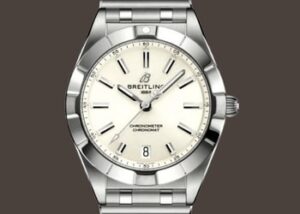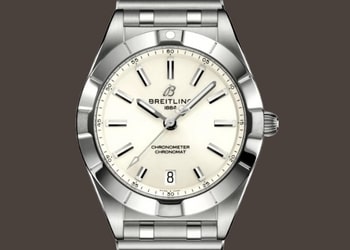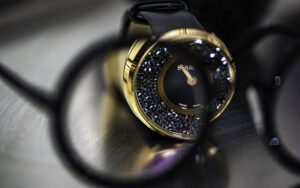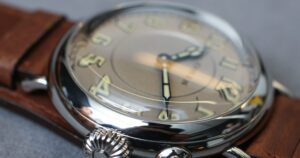Love is in the air, and what says “I love you” better than a luxury timepiece? And if your significant other happens to value precision and innovative complications as much as style, then you may want to consider a Breitling.

Accuracy and Elegance
While Willy Breitling invested considerable time and energy into building excellent chronograph watches, he also loved elegance. And he wasn’t alone. The success of the stylish yet forward-thinking 1940 Chronomat proved that watch enthusiasts appreciated good looks and superior precision.
Breitling’s efforts to give them both culminated in the launch of the Premier line in 1943. He soon followed the Premier with similarly styled but more complicated chronographs, the Duograph and the Datora. The Duograph featured a split-second chrono that let the wearer time two actions simultaneously. The Datora, on the other hand, delighted the owner with day, date, and moon phase functions. All three styles used expensive case and crystal materials and hand-finishes to complete the luxurious look.
Another one of Breitling’s show-stopping masterpieces was the 1964 Top Time. Riding on the professional success of the Navitimer and battling the younger generation’s waning interest in mechanical watches, the brand introduced the unconventional, trendy new line. It was an instant success, exactly what Willy Breitling was shooting for.
On the Breitling website, he is quoted as saying, “We are sweeping into the field of youth, and we are going to speak their language. Young people won’t buy the kind of watch dad wears. They will be interested in a competition watch with special dials and push buttons.”
The Top Time chrono movement delivered all of that and more. It came in traditional round and square casings and sported various face designs and unique features, such as a tachymeter, pulsometer, or decimal scale. And if that didn’t make the Top Time hip enough, the legendary Sir Sean Connery wearing the watch in the James Bond movie “Thunderball” certainly established the watch as the coolest new wearable tech for the amateur adventurer.
Changing of the Guard
As other Swiss brands withered under the pressure of the quartz crisis, often joining forces to stay alive, Breitling weathered the storm by maintaining its independence and embracing the new technology. The key to the marque’s success during this time was the successful handoff from Willy Breitling to the engineer, watchmaker, and aviation enthusiast Ernest Schneider in 1979. Willy wanted to sell the company to a person who would keep Breitling as a stand-alone company known for pushing the boundaries of watchmaking, and he found that man in Schneider.
Throughout the 1980s, 1990s, and early 2000s, Breitling continued to carve out its niche in mechanical and quartz wristwatches that looked to the future of precision timekeeping. These included the “Frecce Tricolori,” a bespoke mechanical chronograph for the Italian army’s aerobatic jet team; the revived Chronomat, with fresh design inspired by the famous Italian jet team watch; the Aerospace Chronograph, a unique quartz-driven timepiece with both digital and analog displays; a re-introduction of the classic Navitimer; the 1995 Emergency, equipped with a mini-antenna for transmitting distress calls; and the Exospace B55, a dual analog and digital watch with smartphone connectivity.
The late 1990s and early 2000s also marked a time when Breitling continued to distinguish itself as a top-tier brand under the guidance of Schneider’s son, Théodore. His corporate background brought agility to the company that it sorely needed. As a result, Théodore led the brand’s successful efforts to COSC-certify (Official Swiss Chronometer Testing Institute) every Breitling chronometer. Since certification requires a watch movement to meet exact standards, this represented a bold move by Schneider.
Additionally, in 1999, Breitling again made aviation history by sponsoring the first non-stop, round-the-world hot air balloon voyage. Pilots Bertrand Piccard and Brian Jones wore Breitling Emergency watches on the celebrated trip. A decade later, in 2009, Breitling developed its first manufacture movement (a movement designed, engineered, and produced completely in-house), the Calibre 01.
“No Borders, Just Horizons”
The period from the Exospace B55 launch through 2017 saw Breitling briefly drop off the map in terms of success and innovation. All that changed when a private equity firm under the leadership of Georges Kern bought the brand that year and began to revive its top, but somewhat forgotten, icons: The Premier, the Navitimer, the Chronomat, the Top Time, and the SuperOcean.
Kern’s revitalization efforts have so far proved extraordinarily successful. Morgan Stanley’s most recent listing of the best-selling luxury watch brands puts Breitling on a consistently upward trajectory since its change of ownership in 2017, rising from 19th to 9th place in just six short years.
With the introduction of new timepieces and updated calibres, one-of-a-kind celebrity brand ambassador squads, and a dedication to sustainability, the future looks bright indeed for the Swiss luxury brand. Forecasters expect the price and popularity of the centenary marque to continue climbing, making vintage and pre-owned pieces especially desirable as the lead time for new models increases.
Sadly, one significant negative side effect of Breitling’s success is the company’s efforts to bring more watch repair services in-house, thus requiring collectors to send in their timepieces for expensive and sometimes lengthy periods of time.
Thankfully, going back to Breitling for maintenance and repair isn’t your only option. If you already own or want to buy one of these exceptional watches, Times Ticking employs Swiss-trained Breitling watch repair experts who can tackle fixing any model. We pride ourselves on the unique ability to acquire original parts, no matter how hard to find, and we take orders from all over the world.
If you’re looking for craftsmanship, precision, and luxury all in one package, Breitling’s your perfect match!




